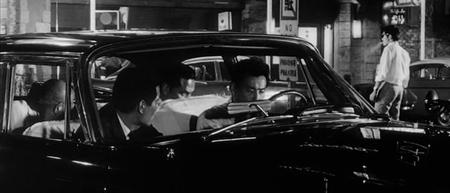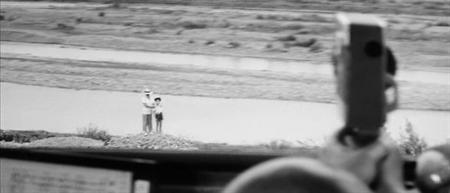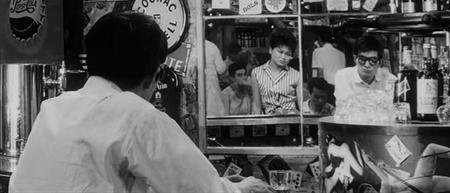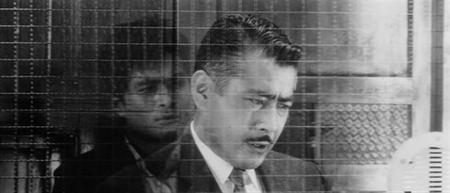
There are highs and lows in Akira Kurosawa’s High and Low (1963): the highs of a master film-maker and the lows that come from privileging technique over drama.
High and Low, based on American Ed McBain’s 1959 pulp thriller King’s Ransom is a noir in four acts: the crime, the investigation, the manhunt, and the confrontation. Kurosawa takes the kidnapping of a young boy as the premise for a hard-edged examination of Japanese society of the period. The film opens in the luxurious house of a shoe company director, Gondo-san, atop a hill in Yokohama overlooking the squalor of the teeming suburbs below. Floor-to-ceiling windows afford a view of a hellish suburbia while insulating his family from the noise of the burgeoning industrial metropolis.

After mortgaging all his assets to fend off a power-play from other directors, Gondo first has to face the ransom demands of a kidnapper for the safe return of his son, and then the decision of whether to pay the hefty ransom to secure the release of his chauffer’s son, who it is later revealed has been mistakenly taken for his son. The drama begins.

Act 1. The executive aerie: angst, cops, phone-calls, and wire-taps
The drapes are drawn – the kidnapper can see right into the living room from somewhere below. At one point the cops crawl on the floor when the kidnapper questions why the drapes are drawn and demands that they be opened. This establishment scenario is expertly staged and edited, but lacks tension. We have to sit through the bickering of a bunch of corporate suits for a lengthy time before the protagonists learn of the kidnapping. The scenario would have worked better with an underlying tension: move the scene where the two boys are seen to go outside and play to the start, then during the corporate shenanigans cross to a fast abduction scene – the audience knows but the protagonists don’t. Kurosawa also appears overly enamored of the wide-screen he has to play with. He fills the frame with all the characters in the room once the cops arrive. There are few close-ups of the personal drama involving Gondo, his wife, and the chauffer, as Gondo battles with the dilemma of not paying the ransom, or paying and facing financial ruin, played out in the presence of the cops who stand or sit in superfluous poses, looking away or at the floor.

Act 2. The pay-off and the manhunt
The pay-off is made from a fast-moving train in six minutes of real time and is exquisitely filmed, edited, and paced. The action then moves onto the investigation and manhunt, with the focus moving away from the family to the cops. We go from high drama to police procedural, which while convincing, goes on for far too long and in tedious detail. Thankfully, the cops while competent are drawn with engaging characters, and there is some welcome humor. Though, I wonder if a Hollywood-b would not have handled it better with more economy and a fast-paced panache.

Act 3. The net closes on the perp
An elaborate setup has the unsuspecting perp, a young cold-blooded killer, meandering through the inner-city streets of low dives and dope dens. In one scene, the fugitive, a chain-smoker in sunglasses, spots Gondo looking in a shop window and cadges a light as a cool as a cucumber. A sequence in a dance-club where the perp goes to score some heroin is brilliantly conceived, with a masterful ebb and flow as he seeks out the dealer. The action then cuts to ‘Dope Alley’ where addicts are operatically hanging out for a fix. This scene is the weakest in the movie: it is plastic and unconvincing. Though there is a certain irony with the soundtrack featuring a single piano note played at intervals.

Act 4. The confrontation
At the end Gondo is confronted with the kidnapper in a prison interview cell. The inchoate anger of the young man is rendered by a simple yet dramatic mis-en-scene. The two men are separated by a wired glass partition. Their conversation is filmed so that the active speaker is shown from the other side through the glass partition with the other man reflected in the glass.
There is a resolution but it does not provide any clear answers. Kurosawa observes more then he analyses. The perp’s motivation is not only a mystery to Gondo but to himself.
This film rewards patience and at 143 minutes also demands it. While a major work, the weaknesses are significant. Moreover, while Kurosawa’s refusal to engage with the social implications of the inequalities he explores are not seen by most critics as a weakness, I would have preferred less police procedure and more social investigation. Kurosawa’s earlier noirs Drunken Angel (1948) and Stray Dog (1949) were stronger in that regard.

Tony: I have long felt there were more “highs” than “lows” in this largely brilliant film, but I’ll definitely have to agree with you on your summary contention that you ‘wished Kurosawa had focused more on social investigation than police procedure.’ Similarly when you assert that at 143 minutes the film demands your patience and attention, I couldn’t agree more. This has never been an easy film to sit through, and it only bears it’s fruit in the last reel, after what some might feel was a turgid stretch. My absolute favorite Kurosawas are the humanist IKIRU, the epic Shakespearean adapatations Ran and THRONE OF BLOOD and the much emulated RASHOMON, but after that I’d name the likes of HIGH AND LOW and one of the two you mention favorably, STRAY DOG. HIGH AND LOW is unique among Kurosawa’s works in it’s style, framing and blending of what seems to be two different films. I would never pose it as any kind of introduction to the director.
Flawlessly cogent analysis, with refreshingly frank perspectives!
LikeLike
Thanks Sam. Your wide exposure to Kurosawa definitely adds weight to your welcome insights.
LikeLike
I appreciate this thorough going over and commend you, but I could never sit through this film, as much as I generally love Kurosawa. I always thought I was watching two different films.
LikeLike
Good point Peter!
LikeLike
A really enjoyable read and analysis. The screen caps are superbly chosen. I’ll be digging up a copy soon, thanks.
LikeLike
Thanks Bobby! Great to have your feedback 🙂
LikeLike
Let’s see…Mifune is great, the ending is rather silly, and much of the framing is right out of the Hitchcock playbook. I guess what I like best is the expressionistic conscription of the city scenes at night.
Exceptional review.
LikeLike
Great stuff Tony. Its been a while since I’ve seen this one. Never one of my Kurosawa favorites. I envy your writing at times. When you stretch out with longer pieces it still remains tight and on point.
LikeLike
Hi! Tony,
What a very interesting review…Unfortunately, I have never watched Kurosawa’s film High and Low (aka Tengoku to jigoku – Japan 1963)
Hence, the reason for no feedback…However, I may seek this film out to watch…Most importantly, I’am tired Of writing… Unfortunately, I have not watched this film yet…with “yet” being the operative word. 😛
Tony,
…Thanks, for sharing!
DeeDee 😉 😀
LikeLike
Thanks DeeDee, Frank, and Maurizio!
LikeLike